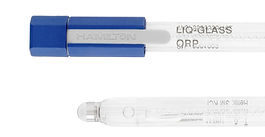
WHAT MAKES PRE-PRESSURIZED SENSORS DIFFERENT?
6 bar of internal pressure ensures that contaminants from the process liquid cannot easily enter the sensor.
WHAT MAKES REFILLABLE SENSORS DIFFERENT?
Processes like pure water, leach electrolyte from the sensor. Sensors like the IonoTrode allow manual refilling without removing the sensor, saving downtime and replacement costs.
WHAT MAKES POLYMER-FILLED SENSORS DIFFERENT?
SINGLE PORE CONCEPT
Instead of a traditional porous diaphragm, polymer sensors use a single pore junction. This design allows 2000 larger contact area for the electrolyte and is extremely difficult to clog.
WHAT MAKES VISCOUS LIQUID-FILLED SENSORS DIFFERENT?
PROVEN TECHNOLOGY
Hamilton has been working with this viscous liquid-filled electrolyte technology for over 20 years.
WHAT IS FOODLYTE?
The Foodlyte electrolyte was specifically developed for the needs of the biotechnology, pharmaceutical, and food industries. It’s based on food ingredients and is the perfect electrolyte for applications where non-toxicity is mandatory. Foodlyte is taste-, odor- and harmless to microorganisms.
HAMILTON ARC TECHNOLOGY
Hamilton Arc revolutionizes the integration of sensors by rethinking communication between sensors, end users, and process control systems (PCS). The functionality of a traditional transmitter has been replaced by a microprocessor within the sensor’s head. Arc sensors communicate directly with the PCS through 4-20 mA standard and digital signals.
WHAT IS A LIQUID EARTH (LEVP) FOR A PH SENSOR?
The liquid earth (LEVP) connection is a separate wire lead immersed in the electrolyte within the reference half-cell of the pH probe. It gets the naming as liquid earth or "solution ground" as it provided a direct connection from the pH transmitter to the solution being measured thus can serve as an earth ground. The ground connection is achieved through the conductive KCl electrolyte and the porous reference liquid junction (diaphragm).
























